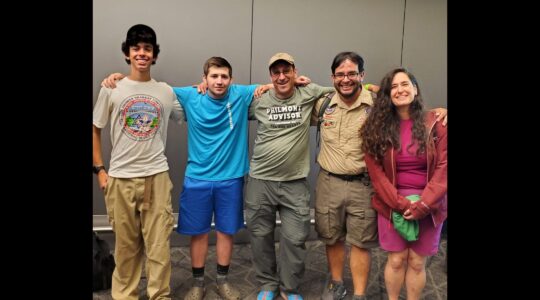JERUSALEM (JTA) — The Eulogizer is a new column (soon-to-be blog) that highlights the life accomplishments of famous and not-so-famous Jews who have passed away recently. Learn about their achievements, honor their memories and celebrate Jewish lives well lived with The Eulogizer. Write to the Eulogizer at eulogizer@jta.org. Read previous columns here.
Edgar Tafel, architect with Wright
Edgar Tafel, the last surviving member of storied architect Frank Lloyd Wright’s original Taliesin Fellowship that began in 1932 at Wright’s home and school in Wisconsin, died Jan. 18 at 98.
On his own, Tafel designed 80 houses, 35 religious buildings and three college campuses, among other projects. In recognition of his achievements, the University of Illinois at Urbana-Champaign’s School of Architecture created an Edgar A. Tafel chair in architecture in his honor.
Tafel was born in 1912 in New York to immigrant parents from Russia who started a dressmaking business but then moved to the anarchist Ferrer Colony in New Jersey, where Tafel attended the Colony’s Modern School. He later attended the avant-garde Walden School before joining Wright from 1932 to 1941 at both Taliesin and Taliesin West, Wright’s summer headquarters and now the location of The Frank Lloyd Wright Foundation.
Tafel was 20 when he arrived at Taliesin, where he drafted, cut stone, made plaster, prepared cement and kept Wright’s pencils sharpened, and also apparently was subjected to anti-Semitic comments and treatment by some of the other acolytes at Taliesin, a community that was cult-like in its adoration of Wright, according to the 2007 book "The Fellowship."
As a senior apprentice to Wright, Tafel worked with him on major projects such as Wingspread (1937), the Johnson Wax Building (1939) and Fallingwater (1939). Tafel left Taliesin in 1941 and served in a photo intelligence unit during World War II. He opened his own architecture firm in New York after the war.
One of his best-known projects was a church house for the First Presbyterian Church at Fifth Avenue and 12th Street in Greenwich Village, a red-brick structure wrapped in balustrades ornamented with cloverleaf-shaped Gothic quatrefoils, emulating the adjoining 19th century church. It came at a time, 1960, when the dominant theme for American architecture was the so-called "glass box" skyscraper.
Tafel maintained an amicable, if sometimes strained relationship with Wright until his death in 1959, and wrote “Apprentice to Genius: Years With Frank Lloyd Wright” in 1979.
Rabbi Nachum Zev Dessler, Orthodox school leader
Rabbi Nachum Zev Dessler, a leader at the Hebrew Academy of Cleveland for more than 60 years and a nationally known leader in Orthodox education, died Jan. 23 at 89.
Dessler, the school’s first principal in 1944, pressed the Jewish Federation of Cleveland to back the school, and it became the first federation in the country to subsidize a full-day Jewish school in 1948. At the end of 2010, the school had nearly 800 students on three campuses in Cleveland and its suburbs, and nearly 6,000 alumni.
Over the years, the school has accepted children from families with all degrees of observance, children of former Soviet Jews who had moved to Cleveland, as well as those with special needs.
“His vision was focused on providing every Jewish child, regardless of religious orientation or ability to pay, a quality Jewish and secular education,” said Ivan Soclof, a past president of the school.
"Each child was truly an individual and was treated like he or she was the most important person in the world," wrote Louis Malcmacher, the Hebrew Academy’s current president. "As a child of Holocaust survivors, my parents came to this country with literally nothing. And as part of Rabbi Dessler’s greatness, the doors to The Hebrew Academy were opened to every Jewish child, no matter what their background was or their ability to pay."
Dessler was born in Lithuania, raised in London, and traveled through Siberia and Japan to reach the United States during World War II, a route similar to that traveled by another recently deceased Orthodox rabbi and educator, Menachem Zeev “Wolf” Greenglass. Dessler arrived in Cleveland in 1941 with students and rabbis to re-establish the Telshe Yeshiva of Lithuania.
Dessler came from a line of rabbis; His father was Rabbi Eliyahu Dessler. Nachum Zev Dessler also was instrumental in building Torah Umesorah, an organization of nearly 700 Orthodox schools.
JTA has documented Jewish history in real-time for over a century. Keep our journalism strong by joining us in supporting independent, award-winning reporting.





